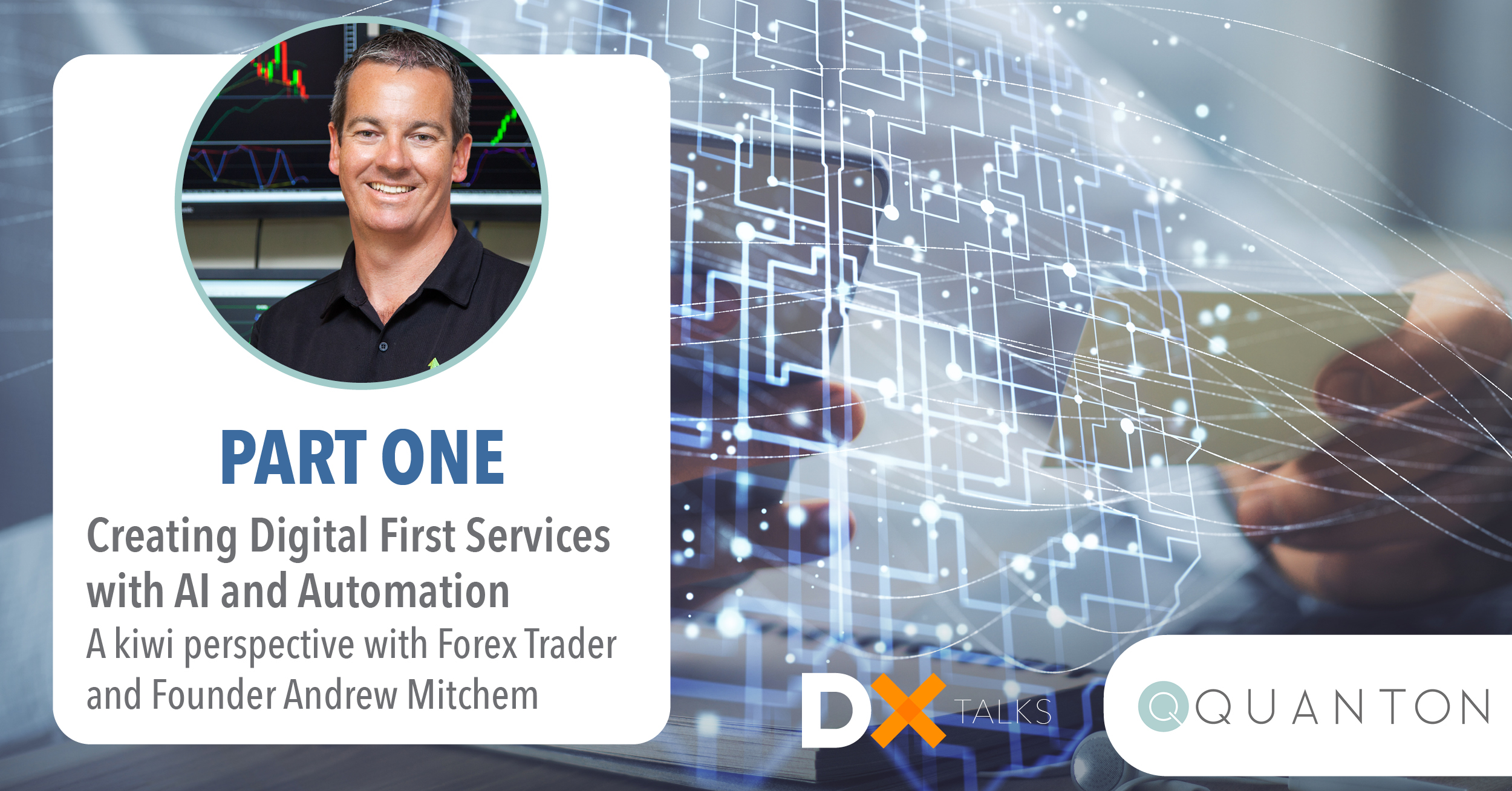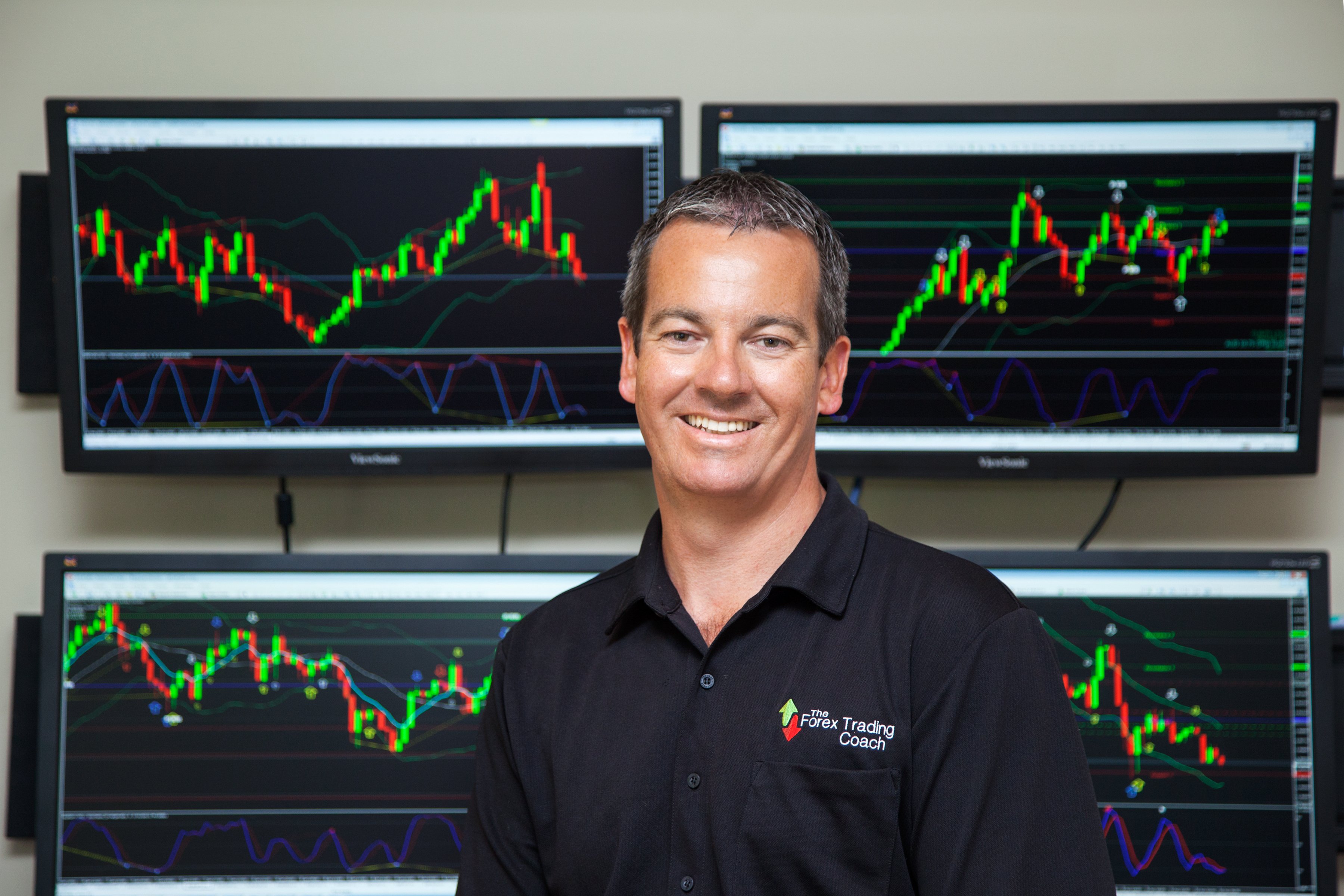
Part one of a two part series
TFTC Pattern Trader, a semi-automated foreign exchange trading platform, underpinned by predictive analytics and machine learning, was delivered to minimum viable product in 12-months and now has over 200 users leveraging the benefits of automation and AI.
Kiwi professional foreign exchange (FOREX) trader, funds manager and FOREX trading coach Andrew Mitchem shares his journey creating a digital first product.
Last year Quanton launched its highly received DX Talks podcast to give business leaders and innovators the insights they need to drive tangible change in their businesses. You can subscribe on most good podcast platforms.Today we launch DX Talks Season Two, with our first ever New Zealand guest, Andrew Mitchem, a professional foreign exchange (FOREX) trader and co-founder of TFTC PatternTrader.
TFTC Pattern Trader is a platform which augments or automates FOREX trading with Machine Learning and Predictive Analytics. The software as a service (SaaS) product was developed in around twelve months and since being launched as a minimum viable product in March 2020 has attracted over 200 paid users globally.
Editors Note: The video contains the full conversation with Andrew Mitchem. The audio podcast has been edited to contain the key points and highlights.
This story shares the journey of creation for an automation and AI led digital service as a SaaS platform. I would say the approach, lessons and philosophies are equally applicable to the transformation of products and service delivery, either holistically or as a sub-set of a total business model.
I believe to date New Zealand businesses are lagging in the adoption of Automation, AI and smart technologies relative to our global counterparts, a belief I've shared in previous episodes. However this doesn't have to be the status quo.
3 of the key 2020 themes that were repeatedly shared by guests were:
- AI and smart technologies are not just for enterprise businesses – they are equally accessible and viable for large and medium businesses.
- Applying AI and smart technologies strategically in your business creates competitive advantage.
- Smart technologies can remove the competitive barriers of size and level the playing field between enterprise and large or medium businesses.
I have been especially looking forward to speaking with Andrew – whose story shows how these messages hold true for Kiwi businesses.
TFTC Pattern Trader is also competing on a global stage and I’ll always take the chance to give props to a Kiwi business taking us to the world.

What is TFTC Pattern Trader and how does it work?
TFTC Pattern Trader is a platform which allows FOREX traders to build robots designed to identify potential trades based on user defined parameters, and then automate or semi-automate trading activity.
Once a potential trade is identified the platform can send an alert to a trader and provide the option to enter the trade automatically with one click or can be set to automatically take trades for the trader, for example, overnight while they are sleeping.
Whether you are buying or selling a currency pair there are three basic elements or points of a trade: The entry, the stop loss and the take profit level. The entry is the price you enter the trade, the stop loss is the price you will exit the trade, with a loss, if the trade goes against you and the take profit level is where a trader will exit a trade, with their profits.
Planes have an auto pilot function, however we still place a highly trained pilot in the cockpit.
While the TFTC Pattern Trader platform is capable of automatically taking trades, Andrew was very specific that the platform is intended to support people who understand FOREX trading and critical aspects like risk management. The platform is not intended to be used by novices and the recommendation for people interested in FOREX trading is to first invest in gaining knowledge, understanding and skill, before augmenting your activities with automation. Andrew also helps to train traders, in his coaching business.
Where predictive analytics and machine learning come into play.
Predictive Analytics
Predictive analytics are used to dynamically determine the paremeters of the trade, to optimise the potential outcome for the trader.
For example, the algorithm will select a take profit level, based on how far price action is likely to extend, setting it further at times when price action has the strength to travel further or closer as required.
The take profit level is optimised for traders to achieve the greatest amount of profit probable from an individual trade, on that specific currency pair, at that time of the day and relative to the current market context.
Conversely the algorithm will select a stop loss level, based on the probability of price action reversing and how far it might reverse. This optimises the level of risk a trader is exposed to and reduces the level of risk where possible to increase key metrics like the risk to reward ratio.
Machine Learning
The algorithms used to determine predictive analytics are underpinned by Machine Learning, so that they are always improving and combining historical precedent with current market context.
Predictive analytics use algorithms to determine the probability of a target variable or target outcome, based on a data inputs for a given case, and relative to the historical data that a model was trained on.
Where problems can occur is when historical data is no longer relevant to current context.
A classic example was given by Colin Priest, VP of AI Strategy for DataRobot, in our episode on Intelligent Automation. If you have a static algorithm designed to predict the demand for toilet paper manufacturing, your algorithm then stopped working in April 2020 during ‘the great toilet paper shortage’ as people frantically prepared for the ‘end of the world’ amidst the Covd-19 breakout. The current market conditions had changed too far beyond the parameters the model was originally trained on.
Likewise, in FOREX trading historical precedent may not completely hold true for a currency during times of extreme uncertainty like a major election or civil unrest.
Using Machine Learning, TFTC Pattern Trader is continually evolving the algorithm used so that predictions are based on a combination of historical precedent and recent context.
Creating a foundation for exponential growth.
In less than 20 years, companies like Google and Facebook have become the behemoths of the enterprise world. Businesses like Uber and AirBnB with their next generation technology have disrupted traditional business models in under 10 years.
For many readers of this article, the objective might not be to become the next Facebook or Uber, but it is likely your strategic planning focusses on how to maintain competitive advantage, how to be more effective, how to remain relevant and what is required to achieve a sustainable level of growth.
Why have these businesses become as successful as they are? How have the grown as fast as they have? What enabled them to achieve a seemingly endless scale? Or, at the very least, how do we prevent the business we are in or we are leading, from becoming the victim of disruption?
At Quanton we’ve recently been focussing on the OpenExO framework, a global transformation ecosystem whose approach provides both an answer to these questions and a framework to help existing business achieve digital transformation, in a way that can drive exponential results.
What I found immediately interesting, is that the business model that Andrew has created for TFTC Pattern Trader has very strong synergies to the OpenExO approach. This offers twelve attributes that are critical aspects of the business models of exponential organisations like Uber, Facebook and Netflix.
OpenExO state that if two of these attributes can be cohesively applied across a mature business model, the conditions for growth will be enabled.
In my conversation with Andrew several of these attributes like the use of algorithms, dashboards and community seemed very evident. Having already achieved 200 users in under twelve months since launch, suggests TFTC Pattern Trader has the right foundation for scalability and future growth.
The conversation around OpenExO is much bigger and we intend to delve in deeper in a future article.
Don't limit innovation within the constraints of your business model.

My perception is that businesses often limit the potential for transformation by constraining the potential for innovation within the constraints of their existing business model.
For example, ‘how do we optimise this function or process'?
The opposite is to start with the user and what you want to enable for them, what outcome you want to create for your customers. The opportunity, then, is to consider how that outcome can be created.
It is possible the best solution may or may not directly link to your existing business model.
When a solution doesn’t directly link to your current business model this may simply signal an opportunity for an independent initiative, which was the case for Andrew and TFTC Pattern Trader, versus a transformation or change to a current business model.
Andrew also touched on a point, which is particularly pertinent if you are transforming individual functions or processes.
You must consider the upstream and downstream impacts of transformation. If you supercharge one element of your business model with automation technology or AI (used as a very broad term), but it creates increased output with dependencies on downstream processing, you may not be able to leverage the full potential benefit. It would be like putting a Ferrari engine in a Toyota Camry body. The engine can probably go a lot faster, than the car body can handle, meaning you would never get the full advantage of the potential power.

Andrew and his co-founder in less than a year took a SaaS product to launch as a minimum viable product and now TFTC Pattern Trader has attracted over 200 users, and Andrew reports is generating positive results.
Underpinned by predictive analytics and machine learning, Andrew’s story is a great example we can look to, to show that AI and smart technologies are accessible to businesses of all sizes and can support initiatives which drive transformative change and create new value for customers and businesses.
Make sure you take a listen to the podcast on the DX Talks platform or subscribe on your favourite platform.
We are going to follow this article up next week, with part two, which will focus on my top five takeaways from speaking with Andrew.

.jpg?width=1232&height=237&name=NEW_Quanton%20Logo%20landscape%20Colour_Hires-01%20(1).jpg)



